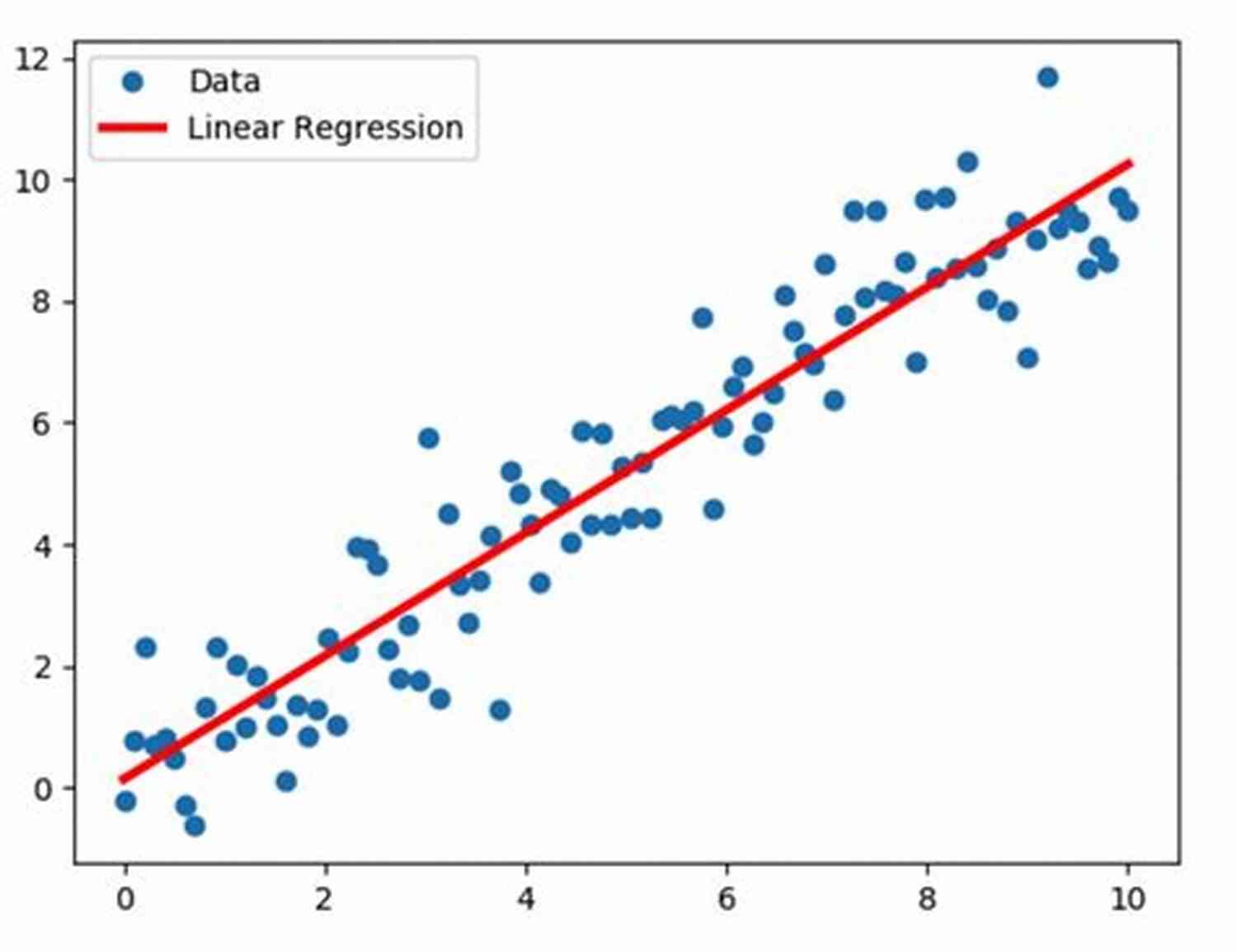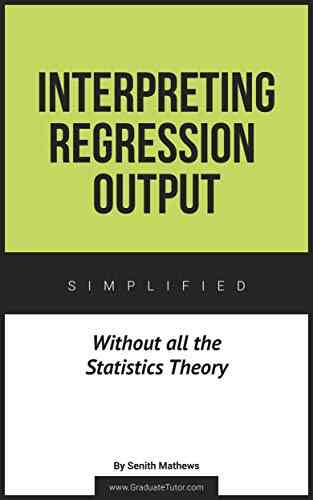Interpreting Regression Output Without All The Statistics Theory


Do you find statistical theory overwhelming when it comes to interpreting regression output? You're not alone! Understanding regression output is crucial for various fields such as economics, finance, and social sciences, but the abundance of statistical jargon and complex concepts can make it seem like an insurmountable task.
Fortunately, in this article, we will break down the process of interpreting regression output without diving deep into statistical theory. By focusing on the practical aspects and providing real-world examples, we will simplify the interpretation process and make it accessible to everyone.
Understanding the Basics: What is Regression?
Before we delve into interpreting regression output, it's essential to grasp the basics of regression analysis. Regression is a statistical technique used to model the relationship between a dependent variable and one or more independent variables. It allows us to examine how changes in the independent variables affect the dependent variable.
4.6 out of 5
| Language | : | English |
| File size | : | 915 KB |
| Text-to-Speech | : | Enabled |
| Screen Reader | : | Supported |
| Enhanced typesetting | : | Enabled |
| Word Wise | : | Enabled |
| Print length | : | 19 pages |
A regression model typically produces several outputs, including coefficients, standard errors, p-values, and goodness-of-fit measures. These outputs provide valuable insights into the relationships between variables and the overall quality of the model.
Interpreting Coefficients
One crucial aspect of interpreting regression output is understanding the coefficients. Coefficients represent the strength and direction of the relationship between the dependent and independent variables.
For example, in a simple linear regression model, the coefficient represents the change in the dependent variable associated with a one-unit change in the independent variable. A positive coefficient indicates a positive relationship, while a negative coefficient indicates a negative relationship.
But how can we determine if the coefficient is statistically significant? This is where p-values come into play. A p-value measures the probability of obtaining results as extreme as the observed ones if the null hypothesis (which assumes no relationship) is true. Usually, a p-value less than 0.05 is considered statistically significant, indicating a high likelihood that the relationship is not due to chance.
Understanding Standard Errors
Standard errors are another important output of regression analysis. They provide an estimate of the variability or uncertainty of the coefficients.
By calculating confidence intervals based on the standard errors, we can determine a range of values within which the true coefficient is likely to fall. If the confidence interval includes zero, it suggests that the variable may not have a significant impact on the dependent variable.
Assessing Goodness-of-fit Measures
Regression output also includes goodness-of-fit measures, which assess how well the model fits the data.
R-Squared, also known as the coefficient of determination, is one commonly used measure. It represents the proportion of variance in the dependent variable that can be explained by the independent variables. A high R-squared value (close to 1) indicates a better fit, implying that the independent variables explain a significant portion of the variation in the dependent variable.
However, R-Squared alone may not provide a complete picture. Adjusted R-Squared takes into account the number of independent variables included in the model, providing a more accurate representation of the model's performance.
Putting It Into Practice: Real-World Examples
To make the interpretation process more tangible, let's explore a couple of real-world examples.
In an economic study examining the effect of education on income, the regression output might show a positive coefficient for the variable "years of education." This indicates that, on average, each additional year of education is associated with an increase in income. The statistically significant p-value further supports the existence of this relationship.
In a marketing research project, regression output might reveal a negative coefficient for the variable "advertising spending." This suggests that as advertising spending increases, sales tend to decrease. Again, the significant p-value validates this finding.
Interpreting regression output doesn't have to be an intimidating task. By focusing on the practical aspects and avoiding unnecessary statistical theory, we can gain valuable insights from regression analysis for various fields.
Remember to consider the coefficients, standard errors, and p-values to understand the relationships and their statistical significance. Additionally, assess the goodness-of-fit measures to evaluate how well the model fits the data.
So don't let statistical theory hold you back. Start interpreting regression output with confidence and unlock the valuable insights hidden in your data!
4.6 out of 5
| Language | : | English |
| File size | : | 915 KB |
| Text-to-Speech | : | Enabled |
| Screen Reader | : | Supported |
| Enhanced typesetting | : | Enabled |
| Word Wise | : | Enabled |
| Print length | : | 19 pages |
Regression analysis is one of multiple data analysis techniques used in business and social sciences. The regression analysis technique is built on a number of statistical concepts including sampling, probability, correlation, distributions, central limit theorem, confidence intervals, z-scores, t-scores, hypothesis testing and more. You may not have studied these concepts. And if you did study these concepts, you may not remember all the statistical concepts underlying regression analysis. ‘Interpreting Regression Output Without all the Statistics Theory’ is for you if you need to read and interpret regression analysis data without knowing all the underlying statistical concepts.
This book is primarily written for graduate or undergraduate business or humanities students interested in understanding and interpreting regression analysis output tables. This book is also helpful for executives and professionals interested in interpreting and using regression analysis. It is a wonderful resource for students or professionals looking for a quick refresher before exams or interviewing for jobs in the data analysis industry.
This book is not intended to replace a statistics text book or to be a complete guide to regression analysis. It is intended to be a quick and easy-to-follow summary of the regression analysis output. ‘Interpreting Regression Output Without all the Statistics Theory’ focuses only on basic insights the regression output gives you.
This book does not assume that the reader is familiar with statistical concepts underlying regression analysis. For example, the reader is not expected to know the central limit theorem or hypothesis testing process. The reader is NOT expected to be an expert in Microsoft Excel, R, Python or any other software that may perform a regression analysis.
Interpreting Regression Output Without all the Statistics Theory is based on Senith Mathews’ experience tutoring students and executives in statistics and data analysis over 10 years.
The first chapter of this book shows you what the regression output looks like in different software tools. The second chapter of Interpreting Regression Output Without all the Statistics Theory helps you get a high level overview of the regression model. You will understand how ‘good’ or reliable the model is. The third chapter of this book discusses the regression equation and helps you find the ingredients of the regression equation. The fourth digs deeper into the regression equation. It helps you interpret the equation and understand its components. The fifth chapter addresses important points you must keep in mind when using regression analysis. It includes the limitations of regression and provides resources and further areas of study if you want to get more proficient in regression analysis.
The companion webpage provides readers with additional resources.
Do you want to contribute by writing guest posts on this blog?
Please contact us and send us a resume of previous articles that you have written.




















Light bulbAdvertise smarter! Our strategic ad space ensures maximum exposure. Reserve your spot today!

 Elmer PowellHeading For Total Eclipse: A Journey through the Kindle Single Ploughshares...
Elmer PowellHeading For Total Eclipse: A Journey through the Kindle Single Ploughshares...
 Grayson BellSacred Stone: The Oregon Files - A Thrilling Adventure That Will Leave You on...
Grayson BellSacred Stone: The Oregon Files - A Thrilling Adventure That Will Leave You on...
 Trevor BellNight Manual Made In Michigan Writers Series - Unveiling the Mysteries of the...
Trevor BellNight Manual Made In Michigan Writers Series - Unveiling the Mysteries of the... Brian BellFollow ·7.3k
Brian BellFollow ·7.3k Branden SimmonsFollow ·6.3k
Branden SimmonsFollow ·6.3k Isaac MitchellFollow ·14.5k
Isaac MitchellFollow ·14.5k Sammy PowellFollow ·7.6k
Sammy PowellFollow ·7.6k Louis HayesFollow ·7.1k
Louis HayesFollow ·7.1k Efrain PowellFollow ·3.8k
Efrain PowellFollow ·3.8k Chase SimmonsFollow ·9.3k
Chase SimmonsFollow ·9.3k Ronald SimmonsFollow ·7.6k
Ronald SimmonsFollow ·7.6k

 Galen Powell
Galen PowellBillionaire Forbidden Romance: Opposites Attract - The...
When it comes to romance, the age-old saying...

 Fletcher Mitchell
Fletcher MitchellThe Midnight Library: A Journey of Self-Discovery and...
Are you seeking an escape from...

 Emilio Cox
Emilio CoxRiad Dubois: The Complete Romance
Imagine a place where time...

 Francisco Cox
Francisco CoxThe Unforgettable Journey through the Enchanting Empire...
Imagine a world where magic dances in the...

 Edmund Hayes
Edmund HayesThe Girl With All The Gifts - A Captivating Tale of...
In the realm of...

 Julio Ramón Ribeyro
Julio Ramón RibeyroHow To House Train Your Dog - The Ultimate Guide
Bringing a new dog into your...

 Allen Parker
Allen ParkerTo Kill Our Worthy Comrade The Lidiya Petrova Papers
On a cold winter night in the heart of Moscow,...

 Terry Pratchett
Terry PratchettUnraveling the Secrets and Power Play: Largo Winch Volume...
Are you ready to embark on another...

 Devin Cox
Devin CoxThe Easiest Way To Make Money In The Stock Market No...
Are you tired of spending countless...

 Walter Simmons
Walter SimmonsFestive Short Mystery Coffee Break Cozies
Looking for a delightful,...

 Ruben Cox
Ruben CoxFlorida Roadkill: Unveiling the Adventures of Serge...
Have you ever wondered what it would be like...

 Esteban Cox
Esteban CoxThe Scandalous Life of Cora Pearl: The Grand Courtesan...
When it comes to the intriguing world of...
4.6 out of 5
| Language | : | English |
| File size | : | 915 KB |
| Text-to-Speech | : | Enabled |
| Screen Reader | : | Supported |
| Enhanced typesetting | : | Enabled |
| Word Wise | : | Enabled |
| Print length | : | 19 pages |
















